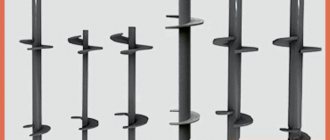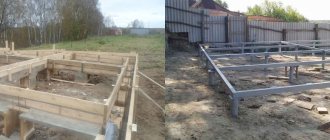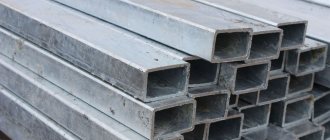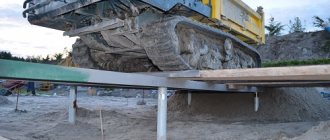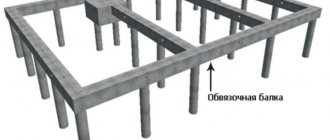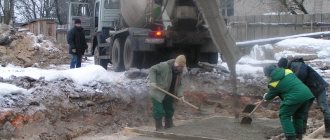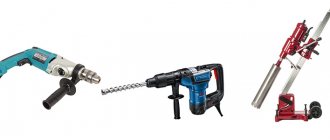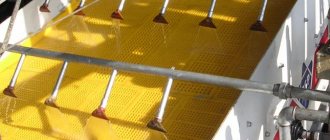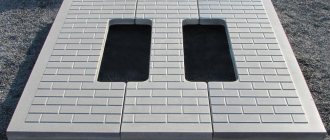The principle of the impact method
The essence of the technology is to drive piles using a directed dynamic force, which is created by a piling hammer. The immersion is carried out until the pile fails. This means that its end has reached a dense layer of soil, and the support has gained the ability to withstand heavy loads.
Driving is carried out using hydraulic and diesel hammers installed on special equipment - a pile driver.
It allows you to perform the following operations:
- Transportation of the pile to the driving site.
- Lifting and vertical installation.
- Connecting a pile with a hammer.
- Moving the hammer along the specified driving direction.
Attention! Impact driving is the optimal way to install piles in terms of cost and productivity on many types of soil.
When driving piles into frozen, hard or rocky soil, the performance of the hammers is reduced. Therefore, a method is used with preliminary drilling of wells into which driving is carried out.
Pile driving methods
There are several methods for driving piles, they all have a common goal: driving piles to the desired point and depth specified in the construction project. Methods:
Various pile driving methods
- Combined (we will consider at the very end of the article).
- Impact method.
- Immersion using vibration method.
- Indentation of piles.
- Piles can be screwed.
- Bored method for driving piles.
These six methods will be discussed in this article, and we will also consider the advantages and disadvantages of each individual method. We will consider combined methods at the very end.
Impact pile driving method
It is the most popular method of all using special impact equipment (various hammers). As mentioned earlier, steam-air and hydraulic hammers are mainly used. There are also diesel hammers. The advantage of this hammer is that its impact energy is 4 times greater than that of others.
A pneumatic impact machine is used for driving. When driving, impacts are carried out at the upper end of the piles. To prevent the piles from being deformed and destroyed after these impacts, equipment called a cap is used. Driving continues until the piles reach the depth required by the construction project. This method is most often used for the construction of industrial buildings and ordinary residential buildings. If the piles are made of reinforced concrete, a truck-mounted crane will be required to easily install them to support the reinforced concrete pile from below.
To select the type of hammer for driving piles, it is necessary to determine the mass of the piles and the hammer. Diesel hammers have the highest productivity and are used for large volumes of work. Mechanical hammers have the lowest productivity and are used for small volumes of work. Diesel hammers will perform work even at temperatures of -30 degrees. Steam-air and hydraulic hammers are used for driving metal and wooden piles. To ensure that the piles are driven in an even direction, hammers are first struck from a low height. In this case, you should make several strikes. When the piles reach the desired depth, a final ten blows are made for each pile at the end.
Vibration method of driving piles
Here, special equipment is used, called a vibratory driver, which will drive the piles precisely vertically. As soon as the end of the pile touches the soil, the vibratory driver is turned on at low speed and gradually immersed in the soil. When the speed of this equipment is reduced, the load on the ground comes only from the side of the piles, otherwise the installation may fail. If the soil layer is hard, another tool is additionally used for this - a vibrating hammer. With the help of a vibratory hammer, piles are driven simultaneously by impacts and vibration. This facilitates rapid immersion of the installation into the soil. If piles are immersed in clay soil, then the bearing capacity of piles of any material is significantly reduced. To prevent this, you need to use the impact method of driving piles. When approximately 25 centimeters remain to the required depth, you need to drive the piles with a mechanical hammer.
The vibration method of driving piles is used for soils saturated with a large amount of moisture. This method can also be used for dense layers of soil, but before driving the piles, you need to drill a well, and only then perform vibration driving. Typically, the vibration-impact method of driving piles is used; it helps to quickly achieve the required depth specified in the construction project. The weight of the impact part of the vibratory hammer should be equal to (at least) half the mass of the piles (the mass depends on the material). It is important to remember that the piles must easily overcome any soil resistance. The resistance of soil with high humidity is overcome by vibration. A dense layer of soil is overcome by blows. The vibration method of driving piles is a labor-intensive process.
Indentation pile driving method
This method is used in areas with dense soil cover. The surface on which the foundation of the house will be built must be completely level. The number of piles for the indentation method will be required much less than for other methods of driving them. At the very beginning, the piles are lowered to a depth of one meter. Then the piles begin to gradually continue to be pressed to the depth required by the construction project. The piles are pressed in by a special self-propelled machine. Typically, the indentation method is used for reinforced concrete piles. The method of driving piles by indentation has a number of advantages:
- When using this method, the greatest strength of the foundation is achieved.
- Using this method, it is much easier to determine the pressure of the structure on the foundation of the house. Foundation settlement is unlikely to occur in the future.
- The immersion of piles can occur in various types of soil.
- Installing reinforced concrete piles using the indentation method will require the least amount of time compared to other methods.
- The cheapest method of driving piles.
- After installing the piles, the load-bearing capacity of the foundation of the house increases.
- No additional work is required to strengthen the piles in the ground.
These advantages make the method of driving piles by pressing one of the best methods. There are three technologies for pressing piles: point, linear and cluster. As mentioned earlier, a pile-pressing machine is used for this method. This machine has its advantages:
- No other equipment or tools will be needed to drive the piles.
- There is no need to drill wells before starting work.
- Using a machine will save your time and effort.
There are pros and cons:
- This equipment is huge and is not suitable for working on small plots of land.
- Huge price.
The pile pressing method is one of the newest methods of driving piles into the soil cover.
Screwing
This method is only suitable for piles with a steel screw tip. Previously, the method of driving piles by screwing was used mainly in industry, but now it has become widespread in the construction of private houses. At the lower end of the pile there is a cone-shaped “shoe”. Screwing is carried out by special installations that are located on the machine, namely capstans. The capstan lowers the pile over the desired location. The pile, in turn, with the help of rotational movements of the tip, drills the soil to the required depth. The method of screwing piles has similar aspects to methods such as impact and vibration. After reaching the depth, the internal cavity of the piles is concreted. The main components of screw piles are the lower and upper parts. One of the main advantages of the method of driving piles by screwing is that, if necessary, they can be easily unscrewed back. Screw piles have many advantages. Let's discuss them:
- Installation is possible both on moist soil and on a hard soil layer.
- Diving can be done at any time of the year (winter, spring, summer, autumn).
- Screw piles are an economical option.
- Doesn't require a lot of construction equipment.
Disadvantages of screw piles:
- The protective shell of piles can be significantly damaged when immersed in a rocky layer of soil.
- Over time, the material from which the piles are made may rust.
Screw piles are used to speed up the process of constructing the foundation of a building. The piles are screwed into the soil layer in a checkerboard pattern. This is a fairly simple process and does not require much effort, but it does require professionalism and diligence in the work. Driving piles using this method should be carried out by a specialized team with professional builders. Of course, this type of construction can be carried out independently, but before installation it is necessary to calculate everything so that there are no negative consequences in the future. Screw piles can be damaged when they are driven into the soil because there may be various obstacles in the soil, such as rocks, tree roots or other objects, all of which can interfere with the driving of the screw piles. To eliminate all these problems, you need to conduct a test drilling of the soil before installation. If the soil contains a large number of stones, then the construction of a pile foundation for a house is impossible. If they occur in small quantities, then it is worth adjusting your calculations, and only then start driving screw piles.
Bored method for driving piles
Before installing cast-in-place piles, it is necessary to drill a hole in the soil cover. All bored piles are reinforced concrete. This method is used both in industry and in the construction of residential buildings. Cast-in-place piles are also used in large-scale projects. At the very beginning, casing pipes, for example, made of roofing felt, are placed into the drilled well. The reinforcement is installed and the concrete mixture is poured. While the concrete has not dried, the casing pipes are removed from the soil layer. This method has only one, but big disadvantage: you will spend a lot of time, since it will take about 30 days for the concrete mixture to harden. Driving bored piles requires professional workers because this process contains several nuances. In places with clayey and sandy soil, the installation of bored piles is not recommended, because the “trunk” of the installation may have an uneven direction. Today, bored pile driving is gaining popularity for dense soils.
Driving combined piles
Driving combined piles
Combined piles - used in places where there is very weak soil cover, and immersion must be carried out to a depth of 25 meters. The material of combined piles is reinforced concrete or steel. It is worth recognizing that combined piles are used in rare cases, compared to other types of pile installations. The lower end of the pile is made of wood, and the upper end is made of reinforced concrete or steel. Combined piles are driven into the soil in a variety of ways, but the most common is the impact method. Therefore, combined piles are driven into the ground with hammers (diesel). They are usually used in the construction of industrial structures. The depth point to which the combined piles need to be immersed is below groundwater (30 meters). Enterprises engaged in the extraction of mineral resources (oil, gas, coal and others) need buildings in which the base is mounted on combined piles. Combined piles are divided into several types. Each of these types has its own advantages and disadvantages. The choice of the type of combined piles depends on the properties of the soil cover. The most common combined pile is one in which the upper end is bored and the lower end is driven.
Advantages of the driving method
The high productivity of the method, compared to static and vibration indentation, installation of piles in this way is common.
Impact method is used:
- When creating foundations for industrial and residential buildings.
- On the construction of waterworks, piers, and buildings on the water.
- For the installation of bridges.
- When installing power lines, laying main pipes.
The technology has limitations for use in urban areas, since the structure of the soil changes and dynamic loads are transferred to neighboring buildings. When using preliminary wells, these restrictions are removed, since driving is carried out with small blows.
The driving equipment is lightweight and small in size, so it can be used even on loose soil. Moreover, the piledrivers are equipped with a highly passable wheelbase.
Advantages
Advantages of indentation pile installation technology:
- Absence of destructive deformations of structures of neighboring buildings and structures. The absence of shock loads and vibration forces ensures the safety and integrity of historical architectural monuments, nearby highways, and utility pipelines.
- Quick installation. The pressing installation is capable of performing a full cycle of work and does not require the installation of additional equipment. The machine's performance allows you to install up to 50 pile supports in one shift.
- Minimum amount of preparatory work.
- Possibility of effective work on any soil base. To overcome weak and subsiding soils and immerse the support in a dense foundation, the indentation method makes it possible to deepen the pile to a level of over 30 meters.
- Increasing the service life of foundation structures. Statistical driving technology greatly reduces the risk of dangerous microcracks forming on the pile body, which during operation can lead to a violation of the bearing capacity of the foundation.
Using computer monitoring, it is possible to adjust the pressure of each submersible support.
The method of pressing in pile supports has virtually no disadvantages.
Equipment used
Driving is carried out with pile driving hammers on pile drivers equipped with tracked and wheeled bases. The performance of driving piles is determined by the mass of the impact element of the hammer. According to it, all equipment is classified as follows:
- heavy – more than 2500 kg;
- medium – 1000-2500 kg;
- light – up to 1000 kg.
The following types of hammers can be used for driving piles:
- UR-1800.
- SP 6V.
- SP-75A.
- Junttan HHK5A.
The first three models are diesel, the last one is hydraulic. For small pile driving operations, UMMC-12 and USA installations are used, equipped with a wheelbase of increased mobility. For large objects, a Junttan PM-20 pile driver is used on a caterpillar basis, equipped with an NNK 5A hydraulic hammer.
Equipment
Installation of pile supports is carried out using modern special equipment - pile pressing machines and installations:
- Installation consists of a strong supporting frame on which a clamping device is installed to secure the submersible pile. Anchor weights are installed on the platform and are used as additional weight for the installation. The necessary pressure to immerse the support into the ground is created by hydraulic pumps located on a separate frame structure.
Pile pressing installation.
- Pile pressing machine A “hydraulic hydrostatic pile driver” consists of a support frame on which the mechanism moving units, a crane and pressing equipment are installed. Anchor weights are placed on the loading platform. The hydraulic pile driver operates as a fully closed-cycle mechanism and does not require the installation of additional equipment.
Hydraulic pile driver.
The choice of equipment depends on the conditions of work at the construction site of a particular facility. It should be taken into account that additional space will be required to place special equipment on the construction site. The implementation of the indentation method is possible on an area of at least 500 m².
How does impact driving happen?
Impact diving is carried out in the following order:
- Marks are made on the pile with dye every meter. They determine the depth of the dive.
- The pile driver delivers the pole to the installation site.
- The pile is fixed and raised to a vertical position, connected to the hammer.
- The position of the pile and its coincidence with the axis of the striker are controlled.
- Hammer strikes with 50% power until immersion of 2 meters. Then the force increases and the pile is driven to failure.
If during the driving process a deviation from the vertical is detected, the post is leveled using the side stops or winches.

